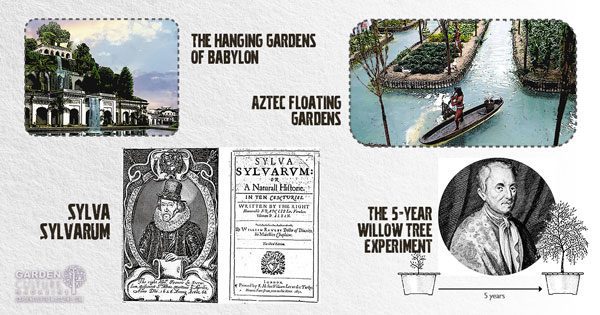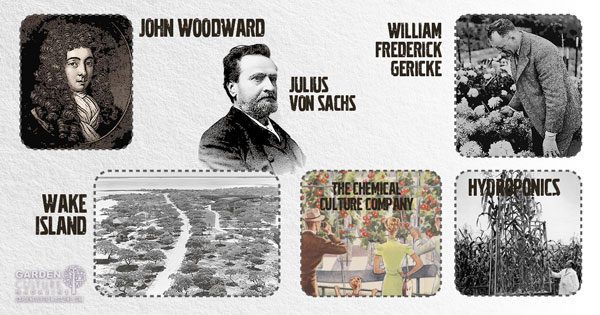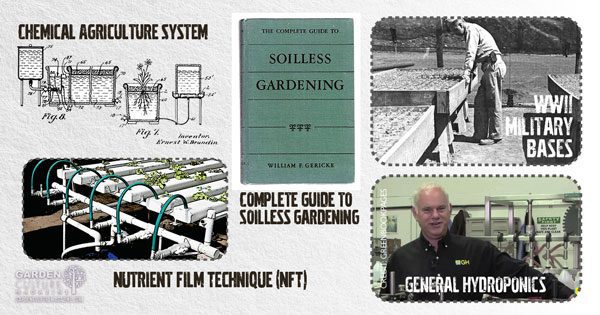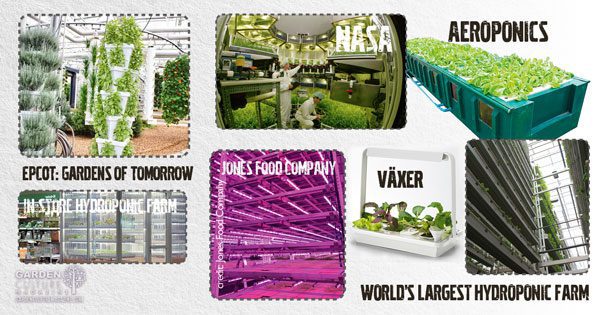Hydroponics is the process of growing plants without soil and is derived from the words “hydro” (water) and the Greek ponein (to labor, toil) and ponos (labor). While hydroponics has grown in popularity and importance over the last 80 years or so, its origins and some of the modern methods we know today date back thousands of years. For a very complete and in-depth dive into hydroponics, check out our multi-part series, “History of Hydroponics.” But for now, you can dip your toes into this fun and fact-filled hydroponics timeline.

600 BC: The Hanging Gardens of Babylon
The Hanging Gardens of Babylon are slightly controversial on a couple of levels. The first is that the gardens, one of the seven wonders of the ancient world, might never have existed. Some texts reference them, but no real archaeological evidence has been found. Secondly, when examining the texts, there are multiple references to the use of soil. However, the irrigation techniques used to get the water throughout the “gardens” do have similarities to methods used in modern hydroponic systems.
1100: Aztec Floating Gardens
The Aztec Floating Gardens are also a little controversial. First off, contrary to popular opinion, these islands, or Chinampas, were attached to the land and not floating freely. But more importantly, while the roots of the plants did grow down through the raft and into the water, the Aztecs did use soil on the rafts, so this wasn’t true hydroponic/soilless growing.
1627: Sylva Sylvarum
The first ‘modern’ book that discusses growing plants without soil is Sylva Sylvarum, written by Sir Francis Bacon and published posthumously the year after his death.
1648: The 5-Year Willow Tree Experiment
An experiment conducted by Flemish Chemist Jean Baptist van Helmont that attempts to determine where plants derive their mass. Van Helmont planted a five-pound willow tree in a pot with 200 pounds of soil. Over the next five years, he added nothing to the pot but distilled water and rainwater. After five years, the tree weighed in at 169 pounds, and the soil only weighed 2 grams less than it had five years earlier. Van Helmont concluded that “164 pounds of wood, barks, and roots arose out of water only.”
1699: John Woodward
Woodward was an English naturalist who, in 1699, published his “water culture” experiments using spearmint grown in different waters (non-pure, distilled). He found that plants grown in less-pure water grew better than those grown in distilled water.
1860: Julius Von Sachs
Professor Sachs publishes the first formula for a nutrient solution that can be dissolved in water to grow plants. This standard formula – with just a few minor tweaks – is used for the next 80 years.
1930s: William Frederick Gericke
Gericke, the “Father of Hydroponics,” while at the University of California at Berkeley, grows tomato vines 25 feet high in his backyard using only water and nutrients.
Wake Island
This rocky atoll in the Pacific Ocean was used as a refueling stop for Pan American Airlines in the 1930s. Because there is no soil there, they had to use hydroponics to grow vegetables for the passengers, becoming one of the early successful use-cases of this growing method.

1937: Hydroponics
Gericke coined the term “hydroponics” (supposedly suggested to him by phycologist W. A. Setchell).
1938: The Chemical Culture Company
Businessman Ernest W. Brundin was very interested in Gericke’s work and ended up experimenting himself by growing tomatoes hydroponically. It went so well, he soon was producing tons of tomatoes and had secured contracts to supply several transcontinental trains and steamships. He named his company, The Chemical Culture Company.
Chemical Agriculture System
In 1938, Brundin also patented the Chemical Agriculture System – the first hobby hydroponic system.
1940: Complete Guide to Soilless Gardening
Gericke left the University in 1937, and in 1940, he published his landmark book, Complete Guide to Soilless Gardening. In the book, he lays out his formula for both macro and micronutrient salts for growing hydroponic plants.
The 1940s: WWII Military Bases
During the war, British and American armies use hydroponics to grow food for service members stationed on rocky islands.
1952: 8 Million Pounds
According to the special hydroponics branch of the US Army, over 8 million pounds of fresh produce is grown for the military using the growing method.
1965: Nutrient Film Technique (NFT)
NFT is a hydroponic technique developed by Allen Cooper at the Glasshouse Crops Research Institute in England. The method involves a very shallow stream, or a “film” of water, recirculating past the bare roots of plants in a gully/channel. All of the required nutrients are dissolved in the water.
1976: General Hydroponics
Founded by Larry Brooke, General Hydroponics develops hydroponic systems and products.

1982: EPCOT: Gardens of Tomorrow
Disney introduces the world to the “gardens of tomorrow” at the brand new Land Pavilion at EPCOT – featuring a number of different hydroponic techniques. The pavilion is still going strong today with interactive hydroponic experiences.
The 2000s: NASA
Over the last few decades, NASA has been doing extensive research into hydroponic growing for its Controlled Ecological Life Support System (CELSS).
2007: 200 Pounds of Tomatoes
Eurofresh farms in Arizona sold more than 200 pounds of hydroponically grown tomatoes.
The 2010s: Organic
The USDA has ruled that hydroponically grown plants can be labeled organic: “Certification to the USDA organic standards is currently allowed, as long as the certifier can demonstrate it is certifying in a way that complies with the standard.”
2014: Aeroponics
Caleb Hunter and his team at the MIT Media Lab discover and develop aeroponics. It is a form of hydroponics – in that it is soilless growing – but instead of the plants sitting in the water, they are sprayed with a nutrient-rich mist. There is no growing medium used either.
2018: Jones Food Company
At 17-Stories high, Jones Food Company is Europe’s largest vertical farm. They were founded in 2016 and started growing their first crops in 2018 in their facility in North Lincolnshire, UK. With 26 tennis courts worth of space and growing 365 days a year, they are producing hundreds of tonnes of produce (fresh herbs, leafy greens, root veggies, soft fruit).

2018: VÄXER
If you thought this one sounds like something you would find at Ikea, you’re right. In 2018, Ikea introduced their VÄXER line of products, providing all you need to grow some hydroponic herbs or veggies at home.
2019: World’s Largest Hydroponic Farm
Emirates Flight Catering and Crop One Holdings are building the world’s largest hydroponic farm in Dubai. The 130,000 square foot facility will be capable of producing over five tonnes of produce every day (all free of pesticides and herbicides). Even though it is soilless, hydroponics uses less water than traditional farming. The company claims that the technology will use just 320 gallons of water and 100 square feet of land to produce the same amount of leafy greens that traditional farming would require 827,640 square feet of land and 250,000 gallons of water to produce.
In-Store Hydroponic Farm
Just last year, Quality Food Centers (QFC) in Seattle teamed up with a vertical-farming startup from Germany, InFarm, to set up in-store hydroponic growing next to the produce aisle in a couple of their locations. They are producing kale, crystal lettuce, and cilantro. Dubai is also introducing in-store hydroponic farms in a few places, producing about 10kg of fresh herbs and microgreens daily – which would typically require up to 1 acre of farmland.
2025: Continued Market Growth
Hydroponics offers many advantages to traditional farming, including using less water, better allocation of space, no soil needed, no pesticides, climate, and environmental control, faster plant growth, and less labor required. And the food it produces is just as tasty and nutritional as it ever was. With all that in mind, and the continued strain population growth is putting on world water and food supplies, some prognosticators are predicting the global hydroponic market to eclipse $16 Billion by 2025 – and to keep going up from there.
“And the food it produces is just as tasty and nutritional as it ever was” this definitely isn’t right . But it’s a great way to go if your on a space ship or live in a region with tough growing conditions, it will never have the flavour of soil grown with love and organic matter. I have been growing my own garden food for over 40 years and the environment makes it tougher but I can say that it rewards me with food that tastes so much better than anything in any store. Also I think when you make the comparison between space and water usage, your probably comparing it against our worst commercial farming practices. I believe hydroponics to be useful tech in it’s place as a last resort and not to just be greedy like most and use it to grow more weight faster with low flavour and quality. Also quite noticeable with cannabis grown over the last 30-35 years -Hydro is never as good. It’s also usually quite reliant on electricity not being interrupted + many other cons like epidemics that can wipe out your whole operation at once. I guess it’s what you do when you have wrecked most of the planet and now want to move on to wrecking and selling other planets we shouldn’t have any right to. Too much greed and automation is ruining us.